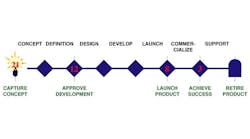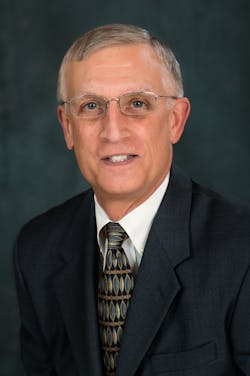Maximizing Revenues from the New Product Pipeline
Now, let's take this same basic concept of a center’s yield and apply it to product development. There are series of centers that take new product concepts and bring them to market. But for these, 100% yields are not expected, nor would we wish them to be. Product development is much more probabilistic. Not every product brought to market is expected to be a financial success. If it were, innovation would dry up as companies would take no risks.
Many studies over the past five decades have found that somewhere between 35% and 55% of products are not financial successes. That figure can be as high as 90% in high-tech and consumer products. Those high failure rates create an opportunity to improve yield without risking the loss of innovation.
There are opportunities in most companies to get more revenues and profits from the product pipeline without increasing investment or headcount. Those opportunities have one common element, better decision making.
Too few ideas: If a company has too few ideas, management is forced to put them all into the pipeline because there are no others to choose from. If management wants to increase yield, they need to create more ideas to choose from. Better ideas increase the pipeline revenues and profits, even if the same number of products is ultimately released. There are just as many companies with too few ideas as there are that have too many ideas.
Too Many Ideas, Part 1: If a company has too many ideas, its challenge is relatively easier. Suppose 12 out of 21 ideas are approved for development. This seems reasonable. However, only eight ever get launched. Somehow, four of the 12 approved products died on the vine. This is a primary indicator that management is clogging the pipeline.
How and why did the four that died on the vine get approved in the first place? Was it because “no” decisions are hard to make? Was it because the business case presented to management at the point of decision was found later to be inaccurate? Was it because all business cases were accurate, but there was simply not enough capacity to do all 12? Was it because the sales organization reached capacity and couldn’t launch any more new products in that time frame? Possibly it was a combination of these reasons, all of which are opportunities to improve the pipeline’s yield.
Of course, there are always “legitimate” reasons for a product dying on the vine. Perhaps a competitor launched a product that was superior to what your company was developing and that necessitated stopping to redefine a better offering.
Too Many Ideas, Part 2: One reason cited in Part 1 was the lack of capacity. Those 12 products might have exceeded available capacity. If so, there is a significant secondary consideration whose logic lies in queuing theory. We have all driven through tollbooths on highways. What happens when there are too many cars on the road? All cars back up behind the tollbooth. The same is true for products in a pipeline. If a work center is overloaded, all products passing through the work center will back up. And all will have a slower time-to-market and increased development cost which lowers yield.
Yield Equates to Money: Suppose in our example, only three products achieved success. All the company’s new product revenues and profits for that financial period stemmed from those three products. Certainly the other five products that launched had some small revenue, and hopefully at least earned back their original development cost, but breaking even is not success. There was a huge opportunity cost to have developed better products that would earn back a multiple of their development costs.
Does your company know the yield of each work center in the product development pipeline? Does your company know when it approves one too many products into development, and the effect that will have on all other products in the pipeline? What can your company do, starting at the point of a product concept, to improve its decisions for each work center?
The goal would be to realize four successful products instead of three. If a company improved to yield four, revenues and profits from new products could immediately jump on the order of 25% without changing anything else but the decisions.


